Report: Business Culture, Maori Culture, and NZ's Economic Landscape
VerifiedAdded on 2023/01/19
|13
|3491
|49
Report
AI Summary
This report delves into the distinctive business culture of New Zealand, exploring its foundations in government policies, the influence of the Maori community, and the impact of the tourism industry. It examines the significance of the Treaty of Waitangi, and the role of Maori culture (Matauranga Maori and tikanga) in shaping organizational ideologies and business practices. The report highlights the contributions of Maori enterprises to the nation's economy, including their investments in various sectors and their impact on employment. Furthermore, it analyzes the tourism industry's role in New Zealand's economic stability, emphasizing heritage management, cultural awareness, and stakeholder engagement. The report also discusses the tensions between preserving natural resources and cultural heritage while facilitating economic development. The report provides a comprehensive overview of the key elements that define New Zealand's business environment and its global standing.
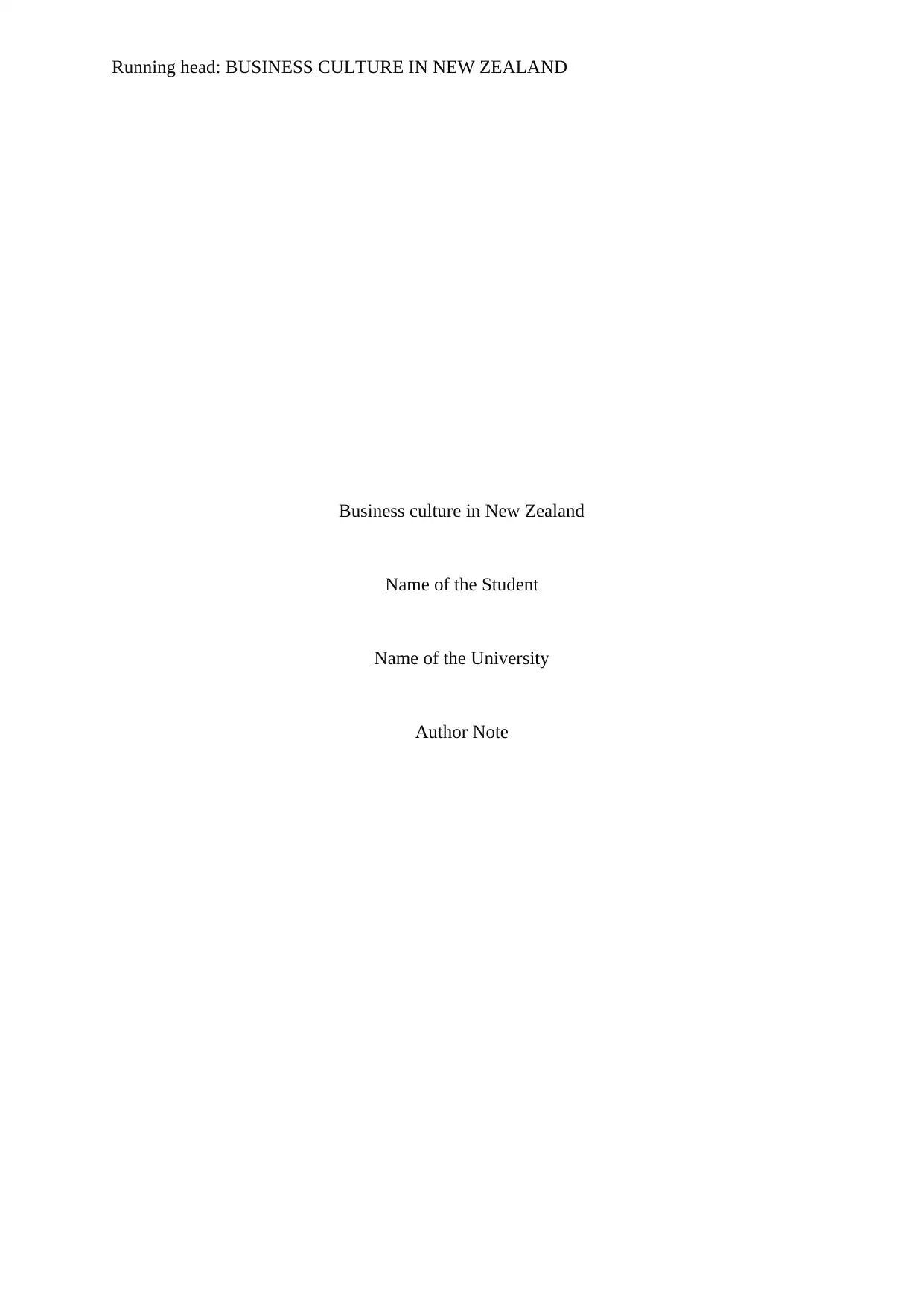
Running head: BUSINESS CULTURE IN NEW ZEALAND
Business culture in New Zealand
Name of the Student
Name of the University
Author Note
Business culture in New Zealand
Name of the Student
Name of the University
Author Note
Paraphrase This Document
Need a fresh take? Get an instant paraphrase of this document with our AI Paraphraser
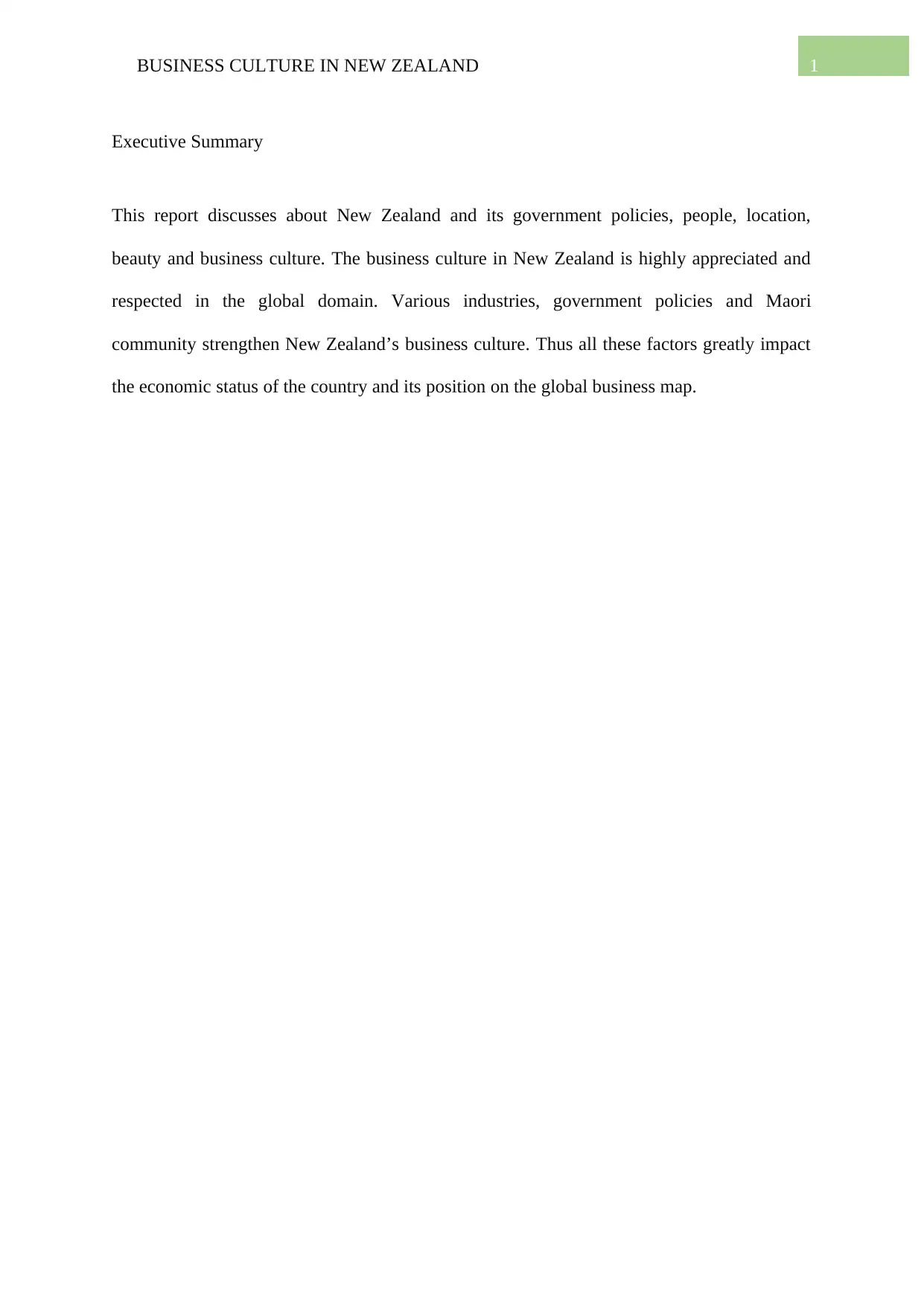
1BUSINESS CULTURE IN NEW ZEALAND
Executive Summary
This report discusses about New Zealand and its government policies, people, location,
beauty and business culture. The business culture in New Zealand is highly appreciated and
respected in the global domain. Various industries, government policies and Maori
community strengthen New Zealand’s business culture. Thus all these factors greatly impact
the economic status of the country and its position on the global business map.
Executive Summary
This report discusses about New Zealand and its government policies, people, location,
beauty and business culture. The business culture in New Zealand is highly appreciated and
respected in the global domain. Various industries, government policies and Maori
community strengthen New Zealand’s business culture. Thus all these factors greatly impact
the economic status of the country and its position on the global business map.
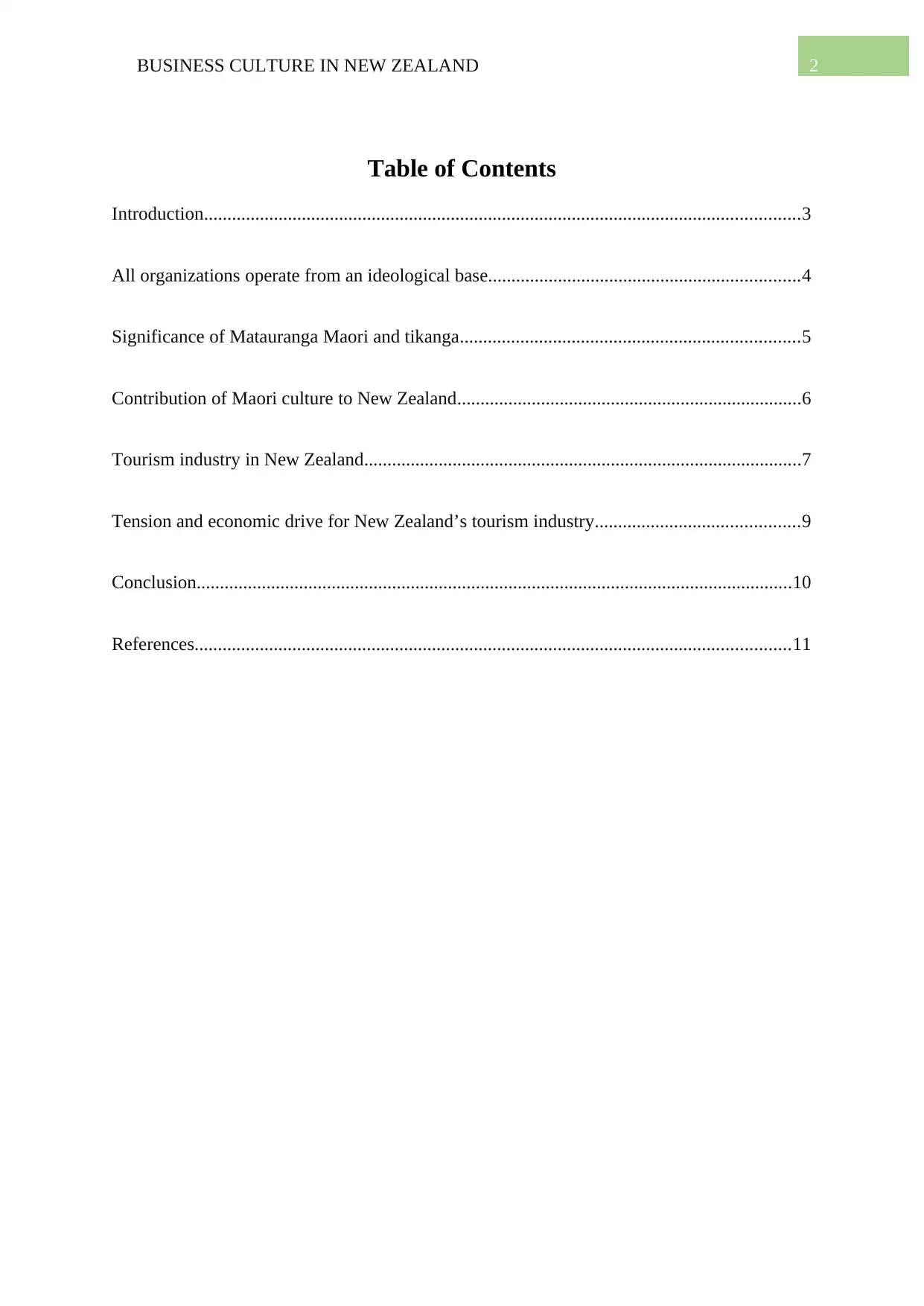
2BUSINESS CULTURE IN NEW ZEALAND
Table of Contents
Introduction................................................................................................................................3
All organizations operate from an ideological base...................................................................4
Significance of Matauranga Maori and tikanga.........................................................................5
Contribution of Maori culture to New Zealand..........................................................................6
Tourism industry in New Zealand..............................................................................................7
Tension and economic drive for New Zealand’s tourism industry............................................9
Conclusion................................................................................................................................10
References................................................................................................................................11
Table of Contents
Introduction................................................................................................................................3
All organizations operate from an ideological base...................................................................4
Significance of Matauranga Maori and tikanga.........................................................................5
Contribution of Maori culture to New Zealand..........................................................................6
Tourism industry in New Zealand..............................................................................................7
Tension and economic drive for New Zealand’s tourism industry............................................9
Conclusion................................................................................................................................10
References................................................................................................................................11
⊘ This is a preview!⊘
Do you want full access?
Subscribe today to unlock all pages.

Trusted by 1+ million students worldwide
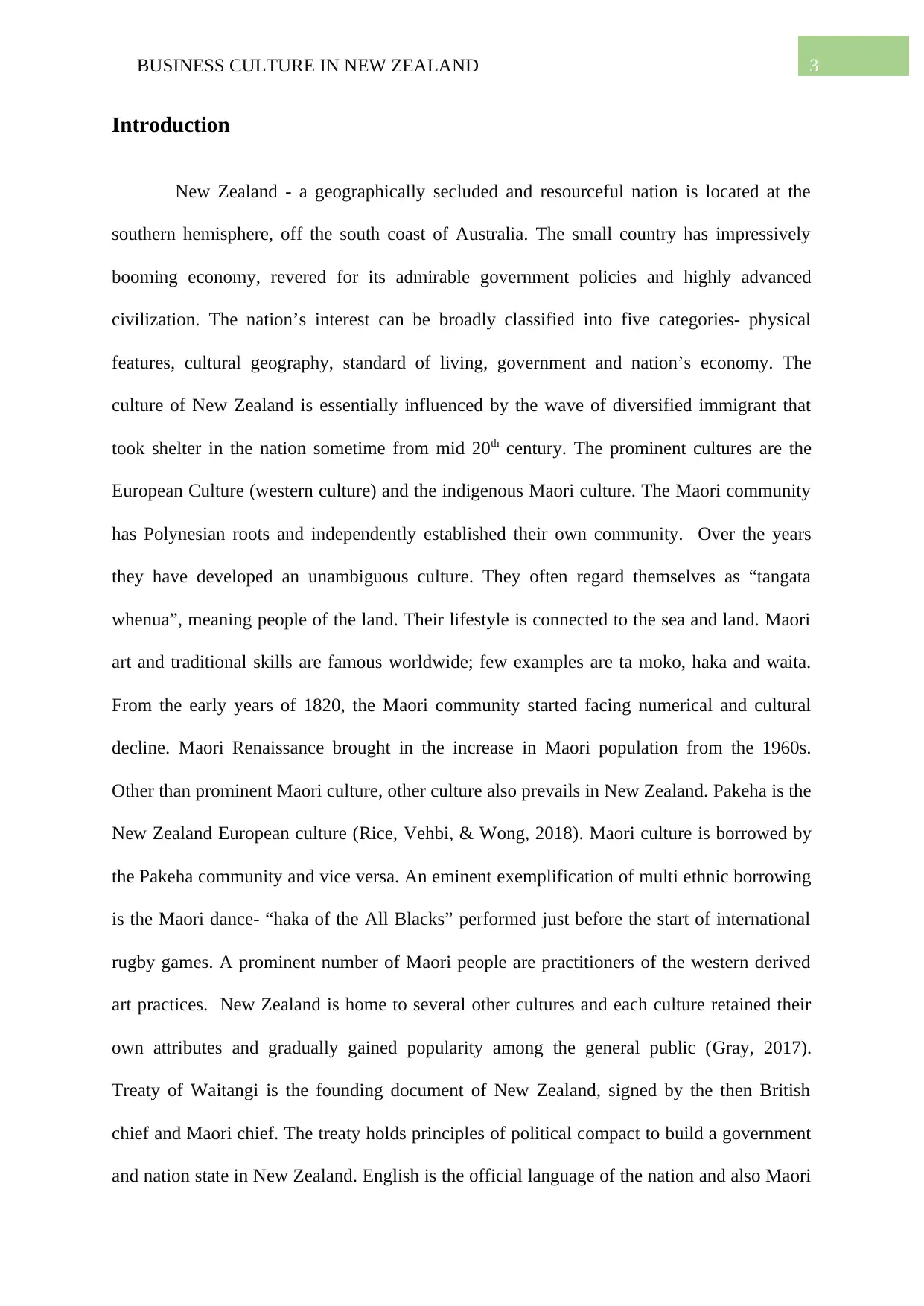
3BUSINESS CULTURE IN NEW ZEALAND
Introduction
New Zealand - a geographically secluded and resourceful nation is located at the
southern hemisphere, off the south coast of Australia. The small country has impressively
booming economy, revered for its admirable government policies and highly advanced
civilization. The nation’s interest can be broadly classified into five categories- physical
features, cultural geography, standard of living, government and nation’s economy. The
culture of New Zealand is essentially influenced by the wave of diversified immigrant that
took shelter in the nation sometime from mid 20th century. The prominent cultures are the
European Culture (western culture) and the indigenous Maori culture. The Maori community
has Polynesian roots and independently established their own community. Over the years
they have developed an unambiguous culture. They often regard themselves as “tangata
whenua”, meaning people of the land. Their lifestyle is connected to the sea and land. Maori
art and traditional skills are famous worldwide; few examples are ta moko, haka and waita.
From the early years of 1820, the Maori community started facing numerical and cultural
decline. Maori Renaissance brought in the increase in Maori population from the 1960s.
Other than prominent Maori culture, other culture also prevails in New Zealand. Pakeha is the
New Zealand European culture (Rice, Vehbi, & Wong, 2018). Maori culture is borrowed by
the Pakeha community and vice versa. An eminent exemplification of multi ethnic borrowing
is the Maori dance- “haka of the All Blacks” performed just before the start of international
rugby games. A prominent number of Maori people are practitioners of the western derived
art practices. New Zealand is home to several other cultures and each culture retained their
own attributes and gradually gained popularity among the general public (Gray, 2017).
Treaty of Waitangi is the founding document of New Zealand, signed by the then British
chief and Maori chief. The treaty holds principles of political compact to build a government
and nation state in New Zealand. English is the official language of the nation and also Maori
Introduction
New Zealand - a geographically secluded and resourceful nation is located at the
southern hemisphere, off the south coast of Australia. The small country has impressively
booming economy, revered for its admirable government policies and highly advanced
civilization. The nation’s interest can be broadly classified into five categories- physical
features, cultural geography, standard of living, government and nation’s economy. The
culture of New Zealand is essentially influenced by the wave of diversified immigrant that
took shelter in the nation sometime from mid 20th century. The prominent cultures are the
European Culture (western culture) and the indigenous Maori culture. The Maori community
has Polynesian roots and independently established their own community. Over the years
they have developed an unambiguous culture. They often regard themselves as “tangata
whenua”, meaning people of the land. Their lifestyle is connected to the sea and land. Maori
art and traditional skills are famous worldwide; few examples are ta moko, haka and waita.
From the early years of 1820, the Maori community started facing numerical and cultural
decline. Maori Renaissance brought in the increase in Maori population from the 1960s.
Other than prominent Maori culture, other culture also prevails in New Zealand. Pakeha is the
New Zealand European culture (Rice, Vehbi, & Wong, 2018). Maori culture is borrowed by
the Pakeha community and vice versa. An eminent exemplification of multi ethnic borrowing
is the Maori dance- “haka of the All Blacks” performed just before the start of international
rugby games. A prominent number of Maori people are practitioners of the western derived
art practices. New Zealand is home to several other cultures and each culture retained their
own attributes and gradually gained popularity among the general public (Gray, 2017).
Treaty of Waitangi is the founding document of New Zealand, signed by the then British
chief and Maori chief. The treaty holds principles of political compact to build a government
and nation state in New Zealand. English is the official language of the nation and also Maori
Paraphrase This Document
Need a fresh take? Get an instant paraphrase of this document with our AI Paraphraser
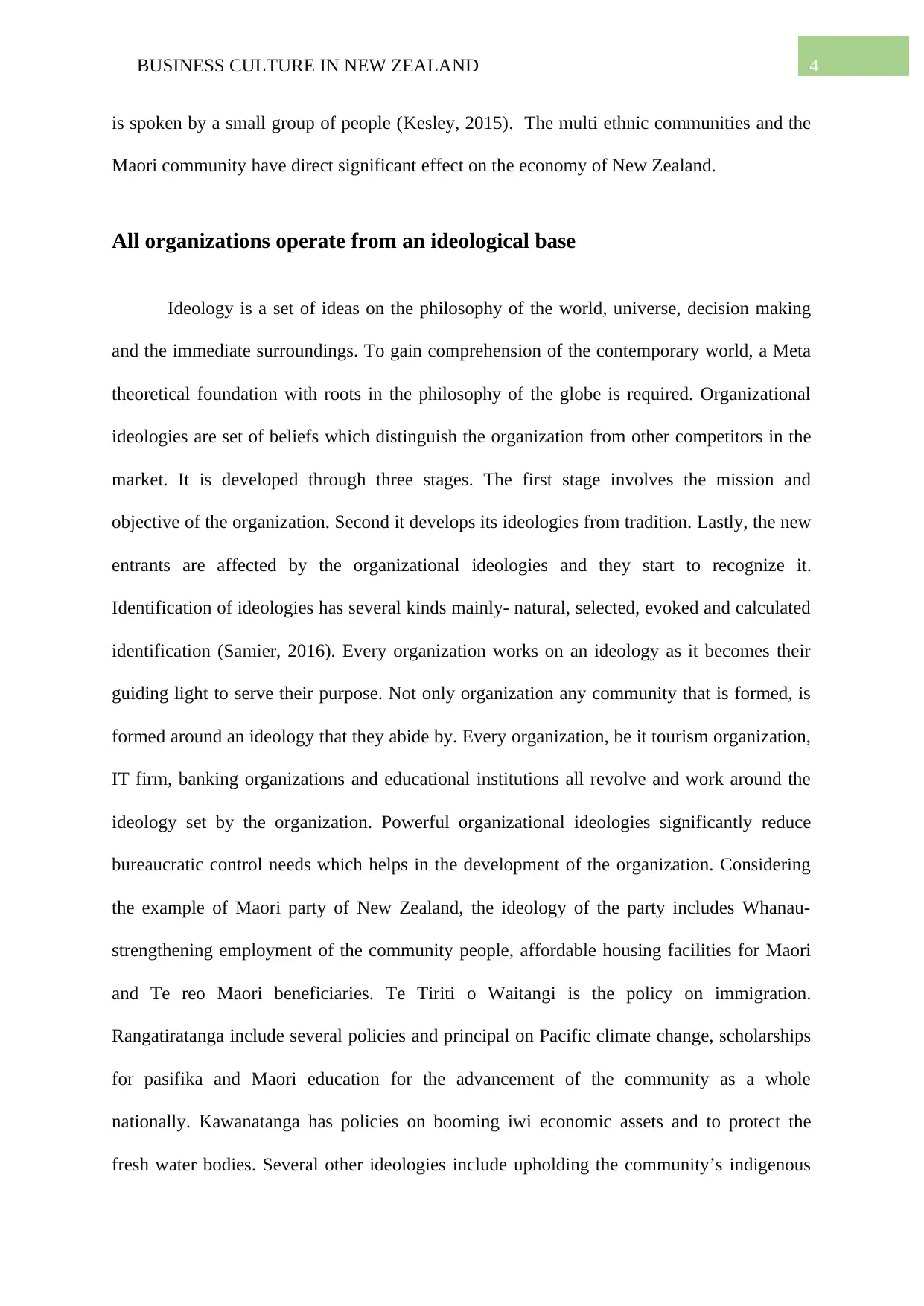
4BUSINESS CULTURE IN NEW ZEALAND
is spoken by a small group of people (Kesley, 2015). The multi ethnic communities and the
Maori community have direct significant effect on the economy of New Zealand.
All organizations operate from an ideological base
Ideology is a set of ideas on the philosophy of the world, universe, decision making
and the immediate surroundings. To gain comprehension of the contemporary world, a Meta
theoretical foundation with roots in the philosophy of the globe is required. Organizational
ideologies are set of beliefs which distinguish the organization from other competitors in the
market. It is developed through three stages. The first stage involves the mission and
objective of the organization. Second it develops its ideologies from tradition. Lastly, the new
entrants are affected by the organizational ideologies and they start to recognize it.
Identification of ideologies has several kinds mainly- natural, selected, evoked and calculated
identification (Samier, 2016). Every organization works on an ideology as it becomes their
guiding light to serve their purpose. Not only organization any community that is formed, is
formed around an ideology that they abide by. Every organization, be it tourism organization,
IT firm, banking organizations and educational institutions all revolve and work around the
ideology set by the organization. Powerful organizational ideologies significantly reduce
bureaucratic control needs which helps in the development of the organization. Considering
the example of Maori party of New Zealand, the ideology of the party includes Whanau-
strengthening employment of the community people, affordable housing facilities for Maori
and Te reo Maori beneficiaries. Te Tiriti o Waitangi is the policy on immigration.
Rangatiratanga include several policies and principal on Pacific climate change, scholarships
for pasifika and Maori education for the advancement of the community as a whole
nationally. Kawanatanga has policies on booming iwi economic assets and to protect the
fresh water bodies. Several other ideologies include upholding the community’s indigenous
is spoken by a small group of people (Kesley, 2015). The multi ethnic communities and the
Maori community have direct significant effect on the economy of New Zealand.
All organizations operate from an ideological base
Ideology is a set of ideas on the philosophy of the world, universe, decision making
and the immediate surroundings. To gain comprehension of the contemporary world, a Meta
theoretical foundation with roots in the philosophy of the globe is required. Organizational
ideologies are set of beliefs which distinguish the organization from other competitors in the
market. It is developed through three stages. The first stage involves the mission and
objective of the organization. Second it develops its ideologies from tradition. Lastly, the new
entrants are affected by the organizational ideologies and they start to recognize it.
Identification of ideologies has several kinds mainly- natural, selected, evoked and calculated
identification (Samier, 2016). Every organization works on an ideology as it becomes their
guiding light to serve their purpose. Not only organization any community that is formed, is
formed around an ideology that they abide by. Every organization, be it tourism organization,
IT firm, banking organizations and educational institutions all revolve and work around the
ideology set by the organization. Powerful organizational ideologies significantly reduce
bureaucratic control needs which helps in the development of the organization. Considering
the example of Maori party of New Zealand, the ideology of the party includes Whanau-
strengthening employment of the community people, affordable housing facilities for Maori
and Te reo Maori beneficiaries. Te Tiriti o Waitangi is the policy on immigration.
Rangatiratanga include several policies and principal on Pacific climate change, scholarships
for pasifika and Maori education for the advancement of the community as a whole
nationally. Kawanatanga has policies on booming iwi economic assets and to protect the
fresh water bodies. Several other ideologies include upholding the community’s indigenous
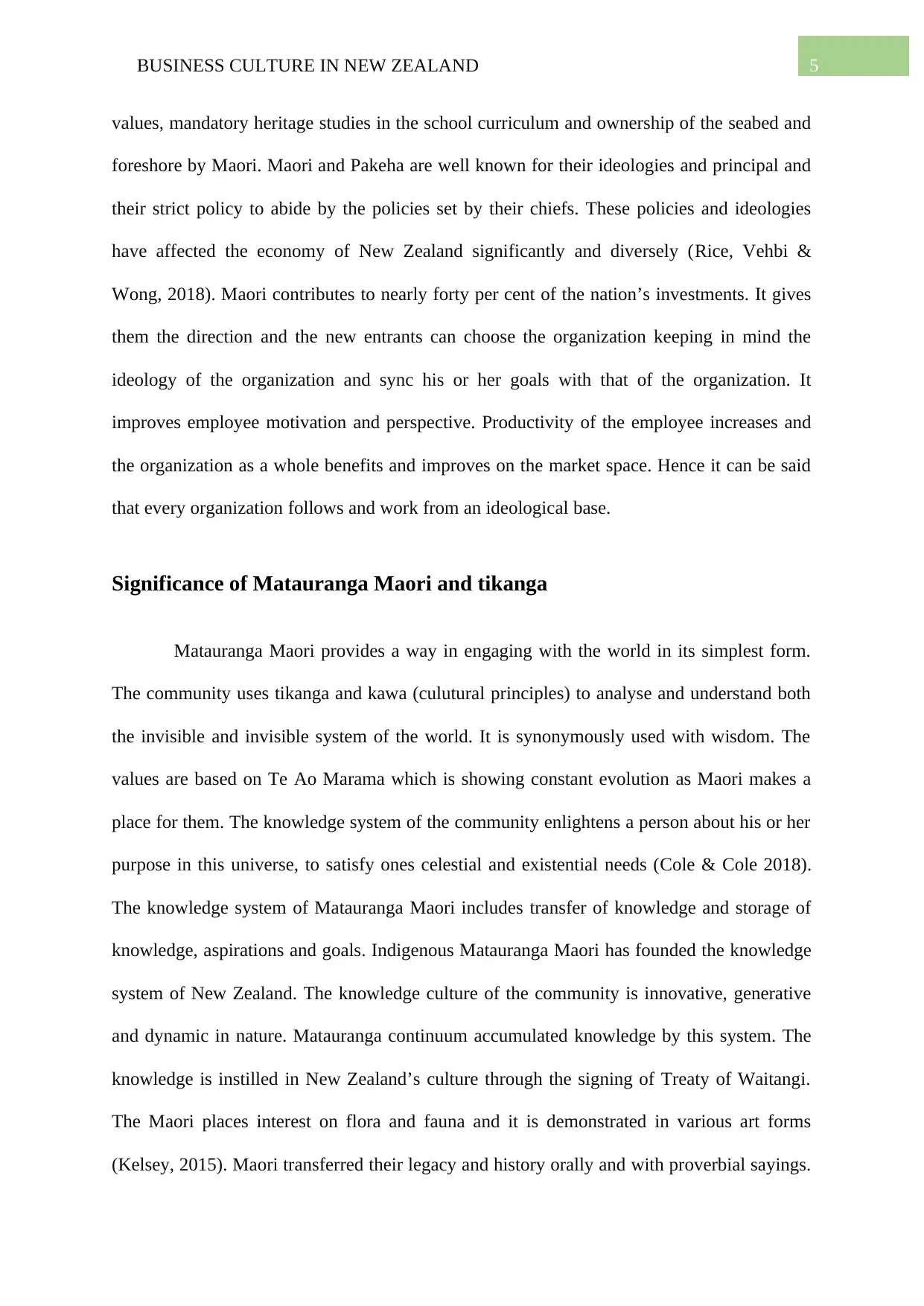
5BUSINESS CULTURE IN NEW ZEALAND
values, mandatory heritage studies in the school curriculum and ownership of the seabed and
foreshore by Maori. Maori and Pakeha are well known for their ideologies and principal and
their strict policy to abide by the policies set by their chiefs. These policies and ideologies
have affected the economy of New Zealand significantly and diversely (Rice, Vehbi &
Wong, 2018). Maori contributes to nearly forty per cent of the nation’s investments. It gives
them the direction and the new entrants can choose the organization keeping in mind the
ideology of the organization and sync his or her goals with that of the organization. It
improves employee motivation and perspective. Productivity of the employee increases and
the organization as a whole benefits and improves on the market space. Hence it can be said
that every organization follows and work from an ideological base.
Significance of Matauranga Maori and tikanga
Matauranga Maori provides a way in engaging with the world in its simplest form.
The community uses tikanga and kawa (culutural principles) to analyse and understand both
the invisible and invisible system of the world. It is synonymously used with wisdom. The
values are based on Te Ao Marama which is showing constant evolution as Maori makes a
place for them. The knowledge system of the community enlightens a person about his or her
purpose in this universe, to satisfy ones celestial and existential needs (Cole & Cole 2018).
The knowledge system of Matauranga Maori includes transfer of knowledge and storage of
knowledge, aspirations and goals. Indigenous Matauranga Maori has founded the knowledge
system of New Zealand. The knowledge culture of the community is innovative, generative
and dynamic in nature. Matauranga continuum accumulated knowledge by this system. The
knowledge is instilled in New Zealand’s culture through the signing of Treaty of Waitangi.
The Maori places interest on flora and fauna and it is demonstrated in various art forms
(Kelsey, 2015). Maori transferred their legacy and history orally and with proverbial sayings.
values, mandatory heritage studies in the school curriculum and ownership of the seabed and
foreshore by Maori. Maori and Pakeha are well known for their ideologies and principal and
their strict policy to abide by the policies set by their chiefs. These policies and ideologies
have affected the economy of New Zealand significantly and diversely (Rice, Vehbi &
Wong, 2018). Maori contributes to nearly forty per cent of the nation’s investments. It gives
them the direction and the new entrants can choose the organization keeping in mind the
ideology of the organization and sync his or her goals with that of the organization. It
improves employee motivation and perspective. Productivity of the employee increases and
the organization as a whole benefits and improves on the market space. Hence it can be said
that every organization follows and work from an ideological base.
Significance of Matauranga Maori and tikanga
Matauranga Maori provides a way in engaging with the world in its simplest form.
The community uses tikanga and kawa (culutural principles) to analyse and understand both
the invisible and invisible system of the world. It is synonymously used with wisdom. The
values are based on Te Ao Marama which is showing constant evolution as Maori makes a
place for them. The knowledge system of the community enlightens a person about his or her
purpose in this universe, to satisfy ones celestial and existential needs (Cole & Cole 2018).
The knowledge system of Matauranga Maori includes transfer of knowledge and storage of
knowledge, aspirations and goals. Indigenous Matauranga Maori has founded the knowledge
system of New Zealand. The knowledge culture of the community is innovative, generative
and dynamic in nature. Matauranga continuum accumulated knowledge by this system. The
knowledge is instilled in New Zealand’s culture through the signing of Treaty of Waitangi.
The Maori places interest on flora and fauna and it is demonstrated in various art forms
(Kelsey, 2015). Maori transferred their legacy and history orally and with proverbial sayings.
⊘ This is a preview!⊘
Do you want full access?
Subscribe today to unlock all pages.

Trusted by 1+ million students worldwide
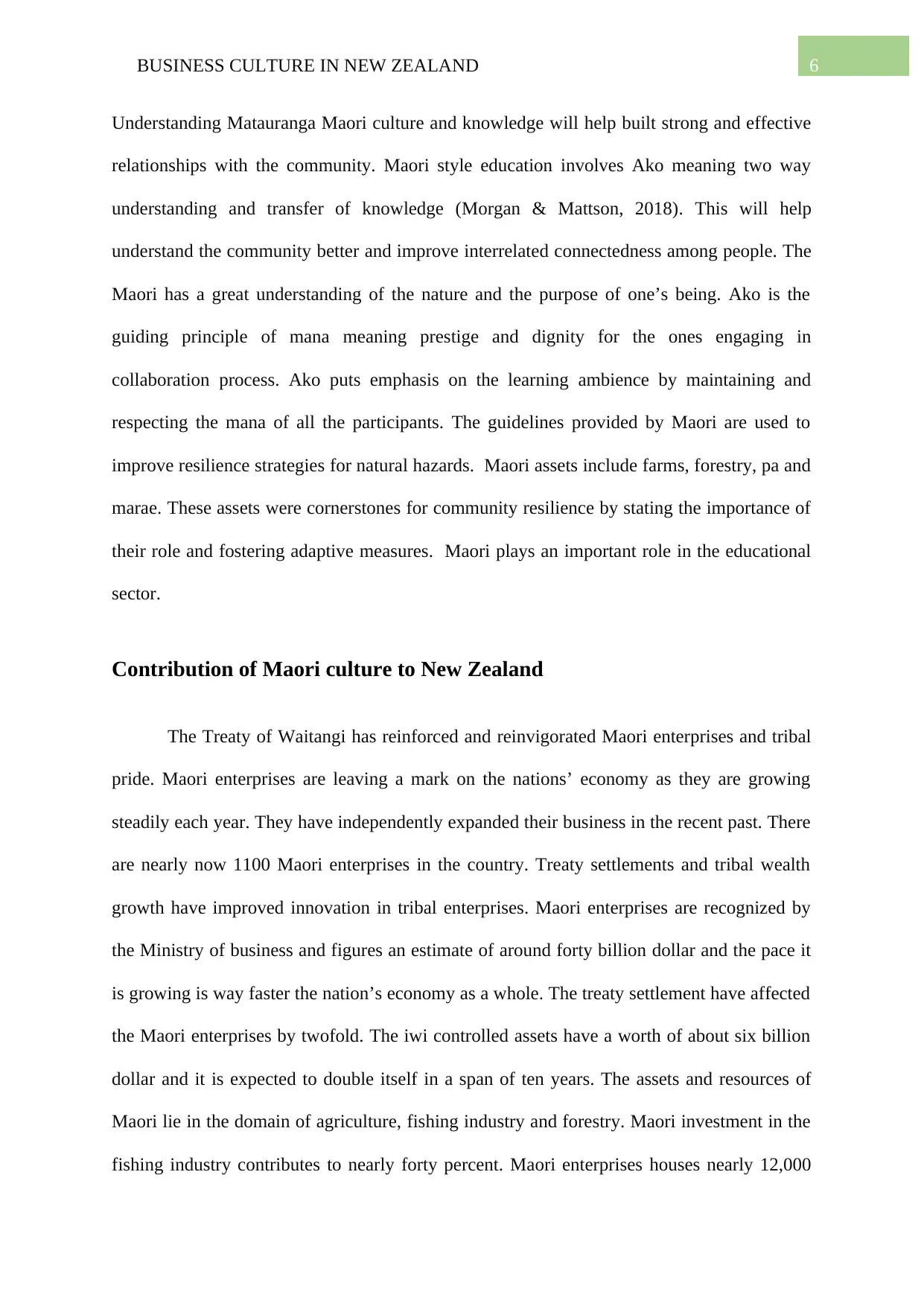
6BUSINESS CULTURE IN NEW ZEALAND
Understanding Matauranga Maori culture and knowledge will help built strong and effective
relationships with the community. Maori style education involves Ako meaning two way
understanding and transfer of knowledge (Morgan & Mattson, 2018). This will help
understand the community better and improve interrelated connectedness among people. The
Maori has a great understanding of the nature and the purpose of one’s being. Ako is the
guiding principle of mana meaning prestige and dignity for the ones engaging in
collaboration process. Ako puts emphasis on the learning ambience by maintaining and
respecting the mana of all the participants. The guidelines provided by Maori are used to
improve resilience strategies for natural hazards. Maori assets include farms, forestry, pa and
marae. These assets were cornerstones for community resilience by stating the importance of
their role and fostering adaptive measures. Maori plays an important role in the educational
sector.
Contribution of Maori culture to New Zealand
The Treaty of Waitangi has reinforced and reinvigorated Maori enterprises and tribal
pride. Maori enterprises are leaving a mark on the nations’ economy as they are growing
steadily each year. They have independently expanded their business in the recent past. There
are nearly now 1100 Maori enterprises in the country. Treaty settlements and tribal wealth
growth have improved innovation in tribal enterprises. Maori enterprises are recognized by
the Ministry of business and figures an estimate of around forty billion dollar and the pace it
is growing is way faster the nation’s economy as a whole. The treaty settlement have affected
the Maori enterprises by twofold. The iwi controlled assets have a worth of about six billion
dollar and it is expected to double itself in a span of ten years. The assets and resources of
Maori lie in the domain of agriculture, fishing industry and forestry. Maori investment in the
fishing industry contributes to nearly forty percent. Maori enterprises houses nearly 12,000
Understanding Matauranga Maori culture and knowledge will help built strong and effective
relationships with the community. Maori style education involves Ako meaning two way
understanding and transfer of knowledge (Morgan & Mattson, 2018). This will help
understand the community better and improve interrelated connectedness among people. The
Maori has a great understanding of the nature and the purpose of one’s being. Ako is the
guiding principle of mana meaning prestige and dignity for the ones engaging in
collaboration process. Ako puts emphasis on the learning ambience by maintaining and
respecting the mana of all the participants. The guidelines provided by Maori are used to
improve resilience strategies for natural hazards. Maori assets include farms, forestry, pa and
marae. These assets were cornerstones for community resilience by stating the importance of
their role and fostering adaptive measures. Maori plays an important role in the educational
sector.
Contribution of Maori culture to New Zealand
The Treaty of Waitangi has reinforced and reinvigorated Maori enterprises and tribal
pride. Maori enterprises are leaving a mark on the nations’ economy as they are growing
steadily each year. They have independently expanded their business in the recent past. There
are nearly now 1100 Maori enterprises in the country. Treaty settlements and tribal wealth
growth have improved innovation in tribal enterprises. Maori enterprises are recognized by
the Ministry of business and figures an estimate of around forty billion dollar and the pace it
is growing is way faster the nation’s economy as a whole. The treaty settlement have affected
the Maori enterprises by twofold. The iwi controlled assets have a worth of about six billion
dollar and it is expected to double itself in a span of ten years. The assets and resources of
Maori lie in the domain of agriculture, fishing industry and forestry. Maori investment in the
fishing industry contributes to nearly forty percent. Maori enterprises houses nearly 12,000
Paraphrase This Document
Need a fresh take? Get an instant paraphrase of this document with our AI Paraphraser
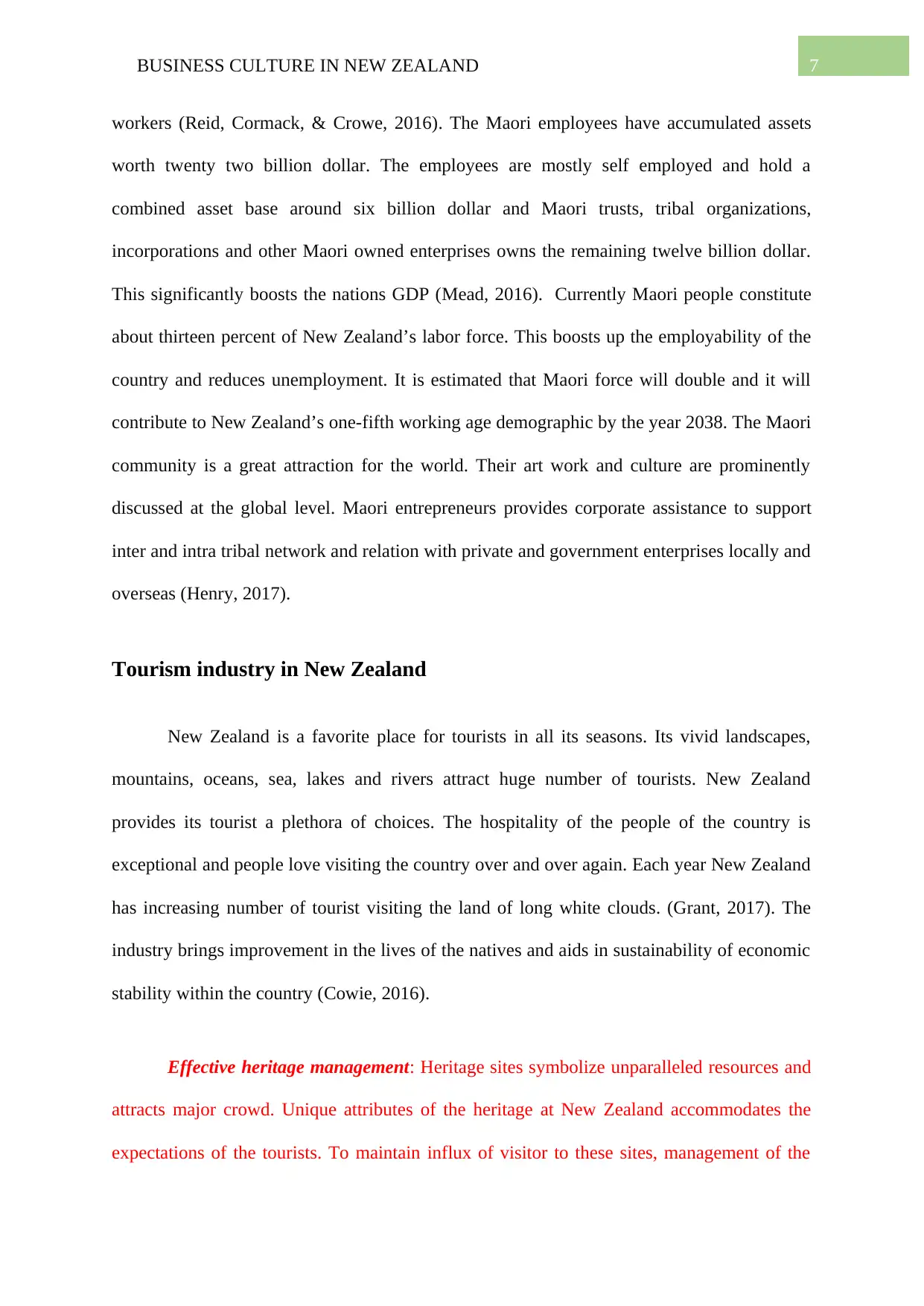
7BUSINESS CULTURE IN NEW ZEALAND
workers (Reid, Cormack, & Crowe, 2016). The Maori employees have accumulated assets
worth twenty two billion dollar. The employees are mostly self employed and hold a
combined asset base around six billion dollar and Maori trusts, tribal organizations,
incorporations and other Maori owned enterprises owns the remaining twelve billion dollar.
This significantly boosts the nations GDP (Mead, 2016). Currently Maori people constitute
about thirteen percent of New Zealand’s labor force. This boosts up the employability of the
country and reduces unemployment. It is estimated that Maori force will double and it will
contribute to New Zealand’s one-fifth working age demographic by the year 2038. The Maori
community is a great attraction for the world. Their art work and culture are prominently
discussed at the global level. Maori entrepreneurs provides corporate assistance to support
inter and intra tribal network and relation with private and government enterprises locally and
overseas (Henry, 2017).
Tourism industry in New Zealand
New Zealand is a favorite place for tourists in all its seasons. Its vivid landscapes,
mountains, oceans, sea, lakes and rivers attract huge number of tourists. New Zealand
provides its tourist a plethora of choices. The hospitality of the people of the country is
exceptional and people love visiting the country over and over again. Each year New Zealand
has increasing number of tourist visiting the land of long white clouds. (Grant, 2017). The
industry brings improvement in the lives of the natives and aids in sustainability of economic
stability within the country (Cowie, 2016).
Effective heritage management: Heritage sites symbolize unparalleled resources and
attracts major crowd. Unique attributes of the heritage at New Zealand accommodates the
expectations of the tourists. To maintain influx of visitor to these sites, management of the
workers (Reid, Cormack, & Crowe, 2016). The Maori employees have accumulated assets
worth twenty two billion dollar. The employees are mostly self employed and hold a
combined asset base around six billion dollar and Maori trusts, tribal organizations,
incorporations and other Maori owned enterprises owns the remaining twelve billion dollar.
This significantly boosts the nations GDP (Mead, 2016). Currently Maori people constitute
about thirteen percent of New Zealand’s labor force. This boosts up the employability of the
country and reduces unemployment. It is estimated that Maori force will double and it will
contribute to New Zealand’s one-fifth working age demographic by the year 2038. The Maori
community is a great attraction for the world. Their art work and culture are prominently
discussed at the global level. Maori entrepreneurs provides corporate assistance to support
inter and intra tribal network and relation with private and government enterprises locally and
overseas (Henry, 2017).
Tourism industry in New Zealand
New Zealand is a favorite place for tourists in all its seasons. Its vivid landscapes,
mountains, oceans, sea, lakes and rivers attract huge number of tourists. New Zealand
provides its tourist a plethora of choices. The hospitality of the people of the country is
exceptional and people love visiting the country over and over again. Each year New Zealand
has increasing number of tourist visiting the land of long white clouds. (Grant, 2017). The
industry brings improvement in the lives of the natives and aids in sustainability of economic
stability within the country (Cowie, 2016).
Effective heritage management: Heritage sites symbolize unparalleled resources and
attracts major crowd. Unique attributes of the heritage at New Zealand accommodates the
expectations of the tourists. To maintain influx of visitor to these sites, management of the

8BUSINESS CULTURE IN NEW ZEALAND
assets is a responsibility for the government (Alvarez, Yuksel, & Go, 2016). The revenue
generated through tourism is used in effectively managing the heritage sites in New Zealand.
Cultural awareness: Festivals in New Zealand pull a huge amount of crowd and the
tourist also participates in the festivals and carnivals with the feeling of oneness. The
attention these festivals receive is tremendous and is very well sponsored internationally
(Shore & Wright 2015). The Maori Kai festival is famous in Aotearoa and attracts a large
number of international visitors. The festival showcases traditional and authentic local culture
and food. The food is cooked in hangi fashion and the portions are served on traditional hand
woven flax baskets. Maori kai festivals have delighted visitors enjoying their culture and
delicacies. Te Ra o Waitangi celebrates union of tangata whenua and the Cown. The festival
engages guests in story-telling, kappa haka and contemporary music. Such festivals allow the
local communities to present themselves and their local pride to the world and gain maximum
popularity. This builds up the strong base for tourism in Aotearoa.
Partnership and Stakeholder engagement: Stakeholder engagement and partnership
is highly essential for successful development of sustainability operation of tourism. The
stakeholders directly and indirectly impact the tourism industry. Government of New Zealand
is the major stakeholder as they are the planners and promoters of tourism on the global
arena. State government promotes local culture and sites on the national platform. Tourists
promote the heritage sites and bring in investments (Woo, Uysal & Sirgy, 2018). Natives are
the most important candidate in the development of the tourism industry in New Zealand, as
it is for their values and culture, the interest towards the nation has increased. Government
partnership with tourism enterprises has been able to increase tourist influx in the country.
assets is a responsibility for the government (Alvarez, Yuksel, & Go, 2016). The revenue
generated through tourism is used in effectively managing the heritage sites in New Zealand.
Cultural awareness: Festivals in New Zealand pull a huge amount of crowd and the
tourist also participates in the festivals and carnivals with the feeling of oneness. The
attention these festivals receive is tremendous and is very well sponsored internationally
(Shore & Wright 2015). The Maori Kai festival is famous in Aotearoa and attracts a large
number of international visitors. The festival showcases traditional and authentic local culture
and food. The food is cooked in hangi fashion and the portions are served on traditional hand
woven flax baskets. Maori kai festivals have delighted visitors enjoying their culture and
delicacies. Te Ra o Waitangi celebrates union of tangata whenua and the Cown. The festival
engages guests in story-telling, kappa haka and contemporary music. Such festivals allow the
local communities to present themselves and their local pride to the world and gain maximum
popularity. This builds up the strong base for tourism in Aotearoa.
Partnership and Stakeholder engagement: Stakeholder engagement and partnership
is highly essential for successful development of sustainability operation of tourism. The
stakeholders directly and indirectly impact the tourism industry. Government of New Zealand
is the major stakeholder as they are the planners and promoters of tourism on the global
arena. State government promotes local culture and sites on the national platform. Tourists
promote the heritage sites and bring in investments (Woo, Uysal & Sirgy, 2018). Natives are
the most important candidate in the development of the tourism industry in New Zealand, as
it is for their values and culture, the interest towards the nation has increased. Government
partnership with tourism enterprises has been able to increase tourist influx in the country.
⊘ This is a preview!⊘
Do you want full access?
Subscribe today to unlock all pages.

Trusted by 1+ million students worldwide

9BUSINESS CULTURE IN NEW ZEALAND
Kaitiakitanga (guardianship and protection) defined as a connection between nature
and human in Maori tradition. It is a mean for managing the flora and fauna. Kaitiaki is the
guardian, who cares for the nature around itself (Walker, 2019). They would use the lunar
calendar to plan their harvest, they took only the amount which was absolutely needed,
hunting and fishing was not considered as sport. Their principal was to guard and protect
Mother Nature and nurture life forces. Tourism has promoted this Kaitiakitanga tradition in
the world forum and now an increase in the interest of Kaitiakitanga ideologies is observed.
Tension and economic drive for New Zealand’s tourism industry
Tourism has essential impact on the economy of New Zealand. It is a direct
contributor to the nation’s GDP as it is a high revenue generating industry. The moderate
percent of the economic growth of the country depends on the tourism industry. The tourism
industry in New Zealand employs around one hundred thousand full time workers and part
time workers which is nearly six percent of the total employment of New Zealand. It greatly
helps the families of the workers to pay their bills, send their children to schools and support
their education. Tourism industry provides adequate healthcare and infrastructure facilities.
As the living cost is high in New Zealand, installing such facilities becomes costly and thus
with the influx of money from the tourism industry helps in installing such facilities. The
tourist brings in huge amount of national and state income.
In the recent days, there has been tension in the tourism industry (Mika et al., 2019).
The concern involves another country in the north, China. A Shanghai bound flight was
coerced to turn mid air to return to its base as later it was known that the flight was not given
the permission to touch down at Shanghai. The government’s feud with a Chinese company
resulted in this escalation. New Zealand lost Chinese tourists as they cancelled their plans to
Kaitiakitanga (guardianship and protection) defined as a connection between nature
and human in Maori tradition. It is a mean for managing the flora and fauna. Kaitiaki is the
guardian, who cares for the nature around itself (Walker, 2019). They would use the lunar
calendar to plan their harvest, they took only the amount which was absolutely needed,
hunting and fishing was not considered as sport. Their principal was to guard and protect
Mother Nature and nurture life forces. Tourism has promoted this Kaitiakitanga tradition in
the world forum and now an increase in the interest of Kaitiakitanga ideologies is observed.
Tension and economic drive for New Zealand’s tourism industry
Tourism has essential impact on the economy of New Zealand. It is a direct
contributor to the nation’s GDP as it is a high revenue generating industry. The moderate
percent of the economic growth of the country depends on the tourism industry. The tourism
industry in New Zealand employs around one hundred thousand full time workers and part
time workers which is nearly six percent of the total employment of New Zealand. It greatly
helps the families of the workers to pay their bills, send their children to schools and support
their education. Tourism industry provides adequate healthcare and infrastructure facilities.
As the living cost is high in New Zealand, installing such facilities becomes costly and thus
with the influx of money from the tourism industry helps in installing such facilities. The
tourist brings in huge amount of national and state income.
In the recent days, there has been tension in the tourism industry (Mika et al., 2019).
The concern involves another country in the north, China. A Shanghai bound flight was
coerced to turn mid air to return to its base as later it was known that the flight was not given
the permission to touch down at Shanghai. The government’s feud with a Chinese company
resulted in this escalation. New Zealand lost Chinese tourists as they cancelled their plans to
Paraphrase This Document
Need a fresh take? Get an instant paraphrase of this document with our AI Paraphraser
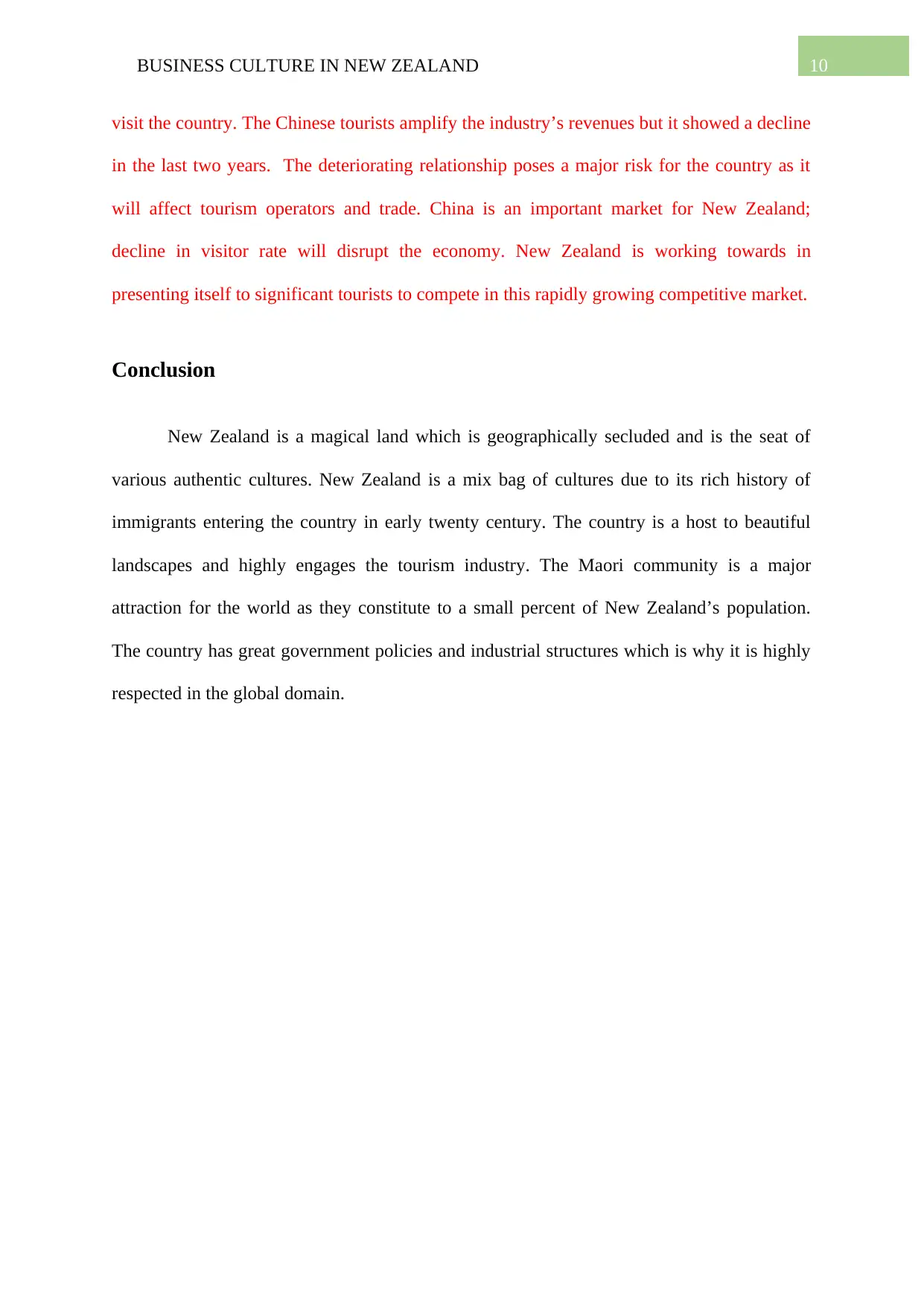
10BUSINESS CULTURE IN NEW ZEALAND
visit the country. The Chinese tourists amplify the industry’s revenues but it showed a decline
in the last two years. The deteriorating relationship poses a major risk for the country as it
will affect tourism operators and trade. China is an important market for New Zealand;
decline in visitor rate will disrupt the economy. New Zealand is working towards in
presenting itself to significant tourists to compete in this rapidly growing competitive market.
Conclusion
New Zealand is a magical land which is geographically secluded and is the seat of
various authentic cultures. New Zealand is a mix bag of cultures due to its rich history of
immigrants entering the country in early twenty century. The country is a host to beautiful
landscapes and highly engages the tourism industry. The Maori community is a major
attraction for the world as they constitute to a small percent of New Zealand’s population.
The country has great government policies and industrial structures which is why it is highly
respected in the global domain.
visit the country. The Chinese tourists amplify the industry’s revenues but it showed a decline
in the last two years. The deteriorating relationship poses a major risk for the country as it
will affect tourism operators and trade. China is an important market for New Zealand;
decline in visitor rate will disrupt the economy. New Zealand is working towards in
presenting itself to significant tourists to compete in this rapidly growing competitive market.
Conclusion
New Zealand is a magical land which is geographically secluded and is the seat of
various authentic cultures. New Zealand is a mix bag of cultures due to its rich history of
immigrants entering the country in early twenty century. The country is a host to beautiful
landscapes and highly engages the tourism industry. The Maori community is a major
attraction for the world as they constitute to a small percent of New Zealand’s population.
The country has great government policies and industrial structures which is why it is highly
respected in the global domain.
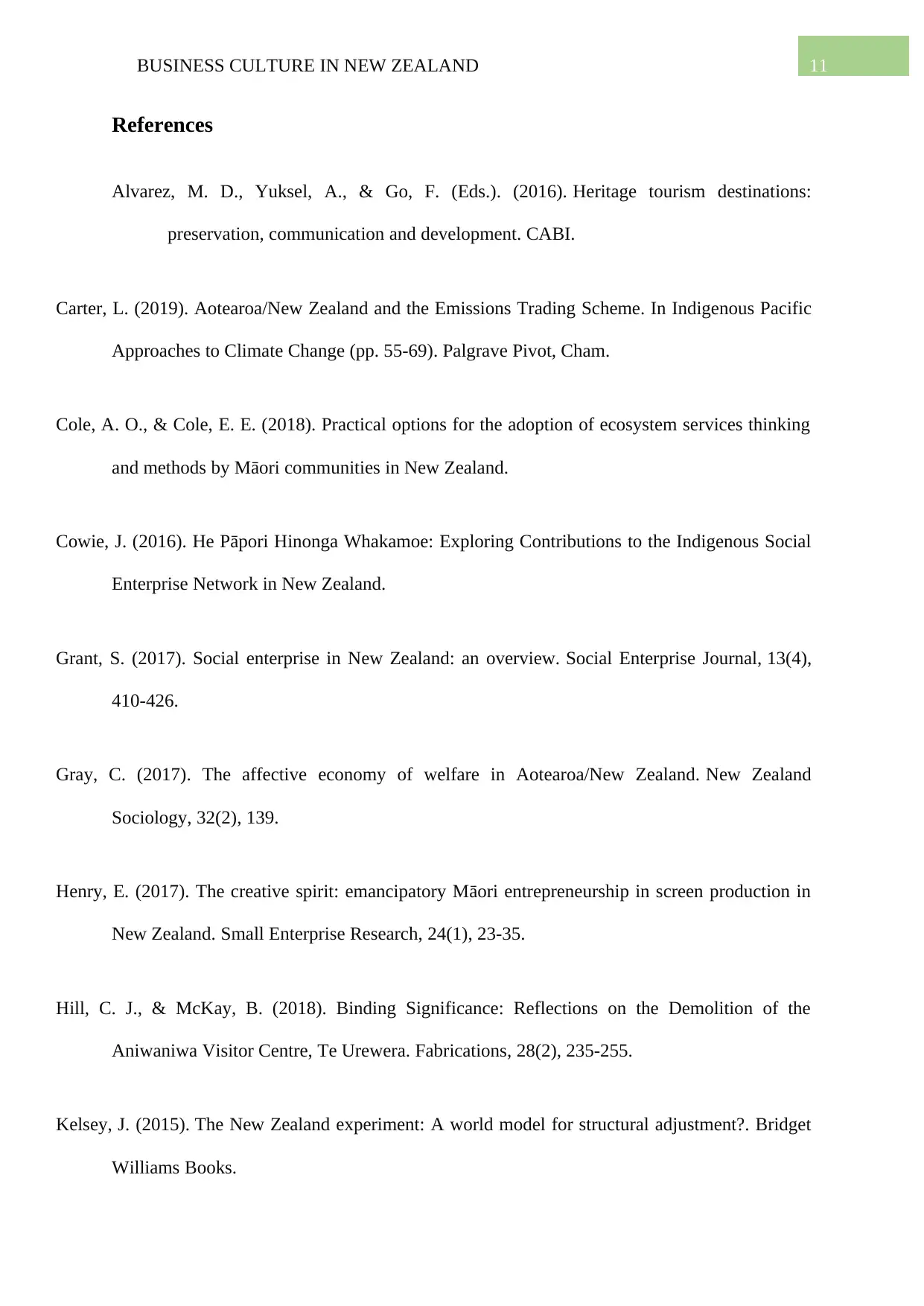
11BUSINESS CULTURE IN NEW ZEALAND
References
Alvarez, M. D., Yuksel, A., & Go, F. (Eds.). (2016). Heritage tourism destinations:
preservation, communication and development. CABI.
Carter, L. (2019). Aotearoa/New Zealand and the Emissions Trading Scheme. In Indigenous Pacific
Approaches to Climate Change (pp. 55-69). Palgrave Pivot, Cham.
Cole, A. O., & Cole, E. E. (2018). Practical options for the adoption of ecosystem services thinking
and methods by Māori communities in New Zealand.
Cowie, J. (2016). He Pāpori Hinonga Whakamoe: Exploring Contributions to the Indigenous Social
Enterprise Network in New Zealand.
Grant, S. (2017). Social enterprise in New Zealand: an overview. Social Enterprise Journal, 13(4),
410-426.
Gray, C. (2017). The affective economy of welfare in Aotearoa/New Zealand. New Zealand
Sociology, 32(2), 139.
Henry, E. (2017). The creative spirit: emancipatory Māori entrepreneurship in screen production in
New Zealand. Small Enterprise Research, 24(1), 23-35.
Hill, C. J., & McKay, B. (2018). Binding Significance: Reflections on the Demolition of the
Aniwaniwa Visitor Centre, Te Urewera. Fabrications, 28(2), 235-255.
Kelsey, J. (2015). The New Zealand experiment: A world model for structural adjustment?. Bridget
Williams Books.
References
Alvarez, M. D., Yuksel, A., & Go, F. (Eds.). (2016). Heritage tourism destinations:
preservation, communication and development. CABI.
Carter, L. (2019). Aotearoa/New Zealand and the Emissions Trading Scheme. In Indigenous Pacific
Approaches to Climate Change (pp. 55-69). Palgrave Pivot, Cham.
Cole, A. O., & Cole, E. E. (2018). Practical options for the adoption of ecosystem services thinking
and methods by Māori communities in New Zealand.
Cowie, J. (2016). He Pāpori Hinonga Whakamoe: Exploring Contributions to the Indigenous Social
Enterprise Network in New Zealand.
Grant, S. (2017). Social enterprise in New Zealand: an overview. Social Enterprise Journal, 13(4),
410-426.
Gray, C. (2017). The affective economy of welfare in Aotearoa/New Zealand. New Zealand
Sociology, 32(2), 139.
Henry, E. (2017). The creative spirit: emancipatory Māori entrepreneurship in screen production in
New Zealand. Small Enterprise Research, 24(1), 23-35.
Hill, C. J., & McKay, B. (2018). Binding Significance: Reflections on the Demolition of the
Aniwaniwa Visitor Centre, Te Urewera. Fabrications, 28(2), 235-255.
Kelsey, J. (2015). The New Zealand experiment: A world model for structural adjustment?. Bridget
Williams Books.
⊘ This is a preview!⊘
Do you want full access?
Subscribe today to unlock all pages.

Trusted by 1+ million students worldwide
1 out of 13
Related Documents
Your All-in-One AI-Powered Toolkit for Academic Success.
+13062052269
info@desklib.com
Available 24*7 on WhatsApp / Email
![[object Object]](/_next/static/media/star-bottom.7253800d.svg)
Unlock your academic potential
Copyright © 2020–2025 A2Z Services. All Rights Reserved. Developed and managed by ZUCOL.





